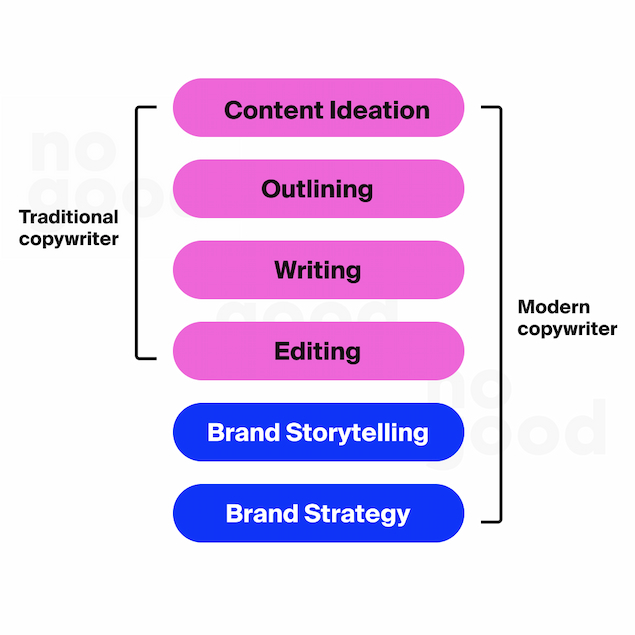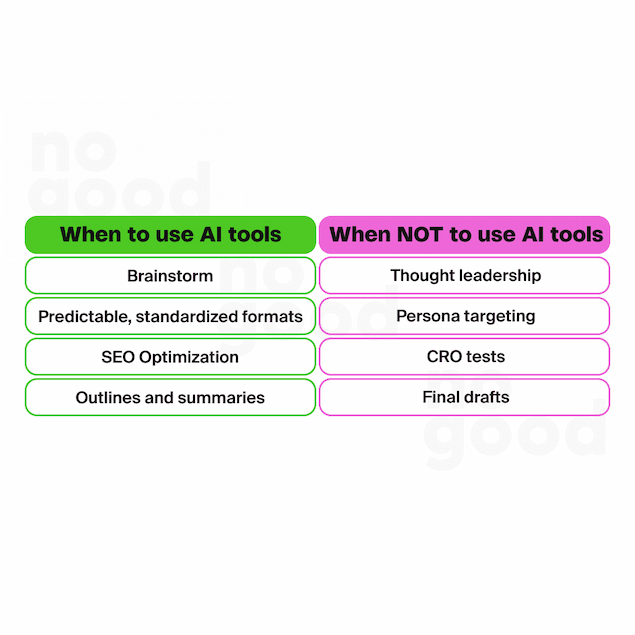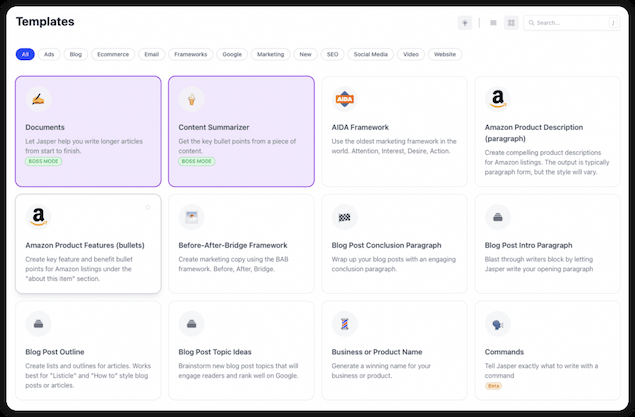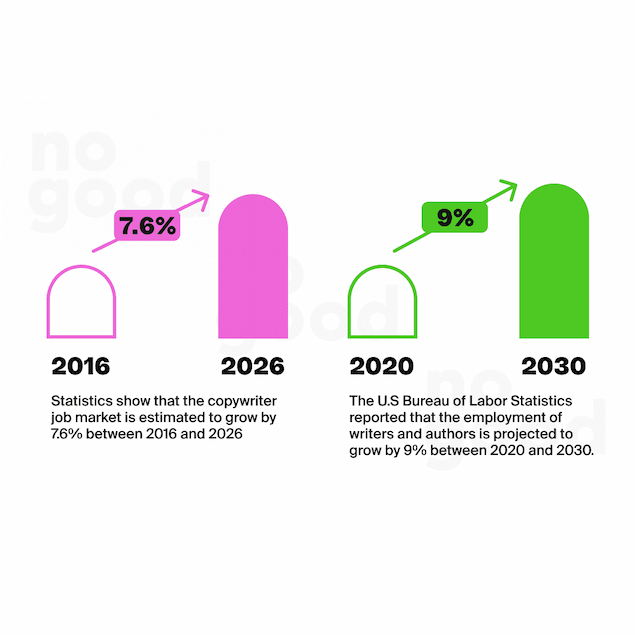Marketers and copywriters are getting anxious — and we don’t blame them. AI copywriting tools like Jasper.AI or Copy.AI are becoming increasingly popularized, and they’re revolutionizing the game by generating high volumes of tailored content in mere seconds. While copywriting is still a highly crucial marketing skill to have, the speed and level at which that skill is performed has exponentially grown as a result of the increasing use of AI copywriting tools.
Rather than asking if AI is replacing humans and copywriters, it’s important to shift that question to ask how copywriters can effectively use copywriting tools to their advantage and not their detriment. The modern copywriter is therefore one who can successfully balance human skill with efficient automation, and who is equipped with expertise on how and when to use AI tools in their work.
Will AI make writers obsolete?
The short answer is no, but the story is far more complex than that. The traditional definition of a copywriter included expertise in writing and crafting compelling marketing copy for a variety of different channels and platforms. However, this definition is now obsolete, but that also means that it’s changing and evolving for the better. Now that most content marketing teams have access to one or more AI tools in their repertoire, writer’s block or time constraints are no longer an excuse.
Copywriters need to seamlessly integrate AI tools into their writing workflows, and hone in on the skills that AIs inherently lack. The “human touch” becomes more important than ever, as writers will need to shift their focus to revising AI-generated content to ensure quality, brand consistency, and platform suitability. In an age where AI tools are able to take care of the writing and creation portion of the job, human copywriters need to expand their skill set and see copywriting as one piece of an overarching marketing strategy in order to avoid becoming obsolete. The best copywriters don’t just create content, they know how to emotionally resonate with their target audience, they understand the narrative of a buyer’s journey, and they know to consider how each piece of content fits into a larger channel or audience strategy.

Copywriters are also emotional storytellers, holding a level of human empathy and resonance that AI tools lack. A large part of marketing copywriting is about building an emotional connection with a reader or consumer to convert them into qualified leads. AI may be able to write within the specifications and constraints of a particular platform, but they still inherently lack the emotional sensitivity and human touch of an experienced copywriter.
Should copywriters use AI?
Copywriters should use AI to automate, speed up and streamline their content writing process. If and when content writers are tasked with generating a large amount of content within a short period of time, they should be using AI tools to increase the efficiency of production. By using AI for the creation part of the writing process, copywriters can spend more time on revision, refinement, and strategy — all of which are crucial in ensuring both high quality and quantity of content.
It is no longer a question of whether or not copywriters should be using AI. AI tools serve the clear purpose of increasing efficiency and speeding up production. The question then lies more in the “how”. How should copywriters integrate AI tools into their writing process? How do copywriters avoid an overreliance on AI tools? How do copywriters know when to use AI and when not to? Let’s get into it.
How should copywriters effectively use AI tools?
In order to effectively use AI tools to your advantage, here are the dos and don’ts of how copywriters should effectively use AI tools.

Do: Use AI tools for brainstorming ideas
Many copywriters admit to spending 60% or more of their time just on the headline. This is because the success of long-form content often depends on noticeable key touch points such as headlines and CTAs. With such high potentiality and limited real estate, it can be challenging to create the “perfect” headline or content piece in an efficient manner. AI copywriting tools can aid this process by generating large amounts of content options that are within a specific character limit so that the copywriter can focus on choosing and editing the best option instead of getting stuck on brainstorming ideas.
Don’t: Use AI tools to compose thought leadership articles
Thought leadership articles or content pieces are important ways for brands and businesses to signal their expertise and establish their authority within a given industry. They help position the brand as a market leader and build trust with its audience. Since AI tools generate copy based on existing content, they are generally not well-suited for writing about emerging or innovative ideas. AI tools reflect, reformat, and report, but they do not predict. Thought leadership requires levels of keen observation and an in-depth understanding of industry trends, which AI unfortunately lacks.
Do: Use AI tools for predictable, standardized formats
AI tools are perfect for generating content for predictable, standardized formats. Most AI copywriting tools have a library of pre-formatted templates, ranging from Amazon product descriptions to social media posts, to Google search ad headlines. For example, Jasper.ai houses an entire library of templates for ads, blogs, eCommerce, emails, and more. These formats often have certain restrictions like character counts or necessary information, and AI writing tools are able to easily generate content within those limitations. The formulaic approach for platform-specific copywriting makes it easy for copywriters to rely on AI for generating content that is specifically suited to a certain use case.

Don’t: Use AI tools for strategic persona targeting
In many ad or landing page strategy frameworks, copy is written to specifically target a certain user or audience persona. A brand strategist will write a brief of what these user personas are, including key information such as demographics, interests, motivators, and unmet needs. Although most AI copywriting tools allow you to specify a certain tone of voice, the depth of strategic persona targeting still requires a level of human touch. Copywriters should lean into their skills in emotional storytelling, and use their understanding of their target audience to craft copy that is tailored to the user persona they’re trying to resonate with. This level of empathy and emotional depth is not something AI tools can currently achieve.
Do: Use AI tools for SEO keyword optimization
When optimizing for a specific targeted keyword, there is usually a list of semantically related keywords and secondary keywords that can be integrated into your content piece to allow it to rank higher on the SERP (search engine results page). Keyword optimization is a fairly straightforward process that involves strategically inserting certain keywords into relevant parts of your content, and many AI tools have templates to assist in this process.

That being said, with Google’s Helpful Content Update, copywriters and SEO experts need to ensure that their keyword-optimized content still takes a human-first approach that best suits and answers the needs of the user in a unique and organic way.
Don’t: Use AI tools for CRO tests
One of the biggest challenges of being a skilled copywriter is navigating and adapting to the various areas of marketing expertise that copywriting intersects with. Copywriting plays a large part in landing page and CRO tests, as certain copy variations can serve as the foundation of A/B testing frameworks. When following a CRO testing framework, it is better not to rely on AI tools so as to avoid diverging from the goals and objectives of the test. CRO tests must be executed with precision and thoughtfulness to ensure that the results provide leverageable learnings and insights to drive further growth.
Do: Use AI tools for outlines and summaries
AI copywriting tools are great for outlines and summaries because they simplify content rather than elaborating on it. By subtracting rather than adding, there is less of a risk that the AI will incorrectly neglect crucial pieces of information. Outlines and summaries are also typically shared only for internal use and communication, thus negating the need for a consideration of brand positioning, target audience personas, and any other outward-facing brand elements that require more of a human touch.
Don’t: Use AI tools for final drafts
AI-generated content can be a great starting point, but it should not be used as a final draft. As a rule of thumb, even the most predictable, standardized content pieces should be looked over before it is published. Whether it’s an AI or a human, mistakes, and inconsistencies happen, and copywriters should always have editing and revision as part of their writing process no matter what.
Is there a demand for copywriters?
Despite the ubiquity of AI copywriting tools, copywriters are still in very high demand. Statistics show that the copywriter job market is estimated to grow by 7.6% between 2016 and 2026. The U.S Bureau of Labor Statistics also reported that the employment of writers and authors is projected to grow by 9% between 2020 and 2030. The catch with this growth is that while the demand for skilled copywriters is growing, the demand for novice writers is simultaneously decreasing. Since AI tools have more or less taken over the content creation portion of copywriting, agencies and in-house marketing teams are more interested in hiring copywriters that have more of a strategic understanding of how copywriting affects the overall marketing funnel. An unfortunate side effect of this shift implies that this shift will eventually deplete the pool of experienced writers by throttling demand for more junior writers.

Even as AI copywriting tools continue to become more and more advanced, it’s likely that the demand for skilled copywriters will continue to be strong. AI builds on and learns from existing information, meaning that they follow and adapt to trends rather than create them. The nature of the marketing industry is constantly changing; new platforms arise, formats change, and brands need to constantly innovate in order to keep up with the pace of cultural and consumer evolution. Brands need to work with skilled copywriters who not only understand how to effectively leverage AI tools, but also how to revise AI-generated content to best resonate with the most current cultural landscape and behavioral trends.
Does copywriting have a future?
Copywriting is a crucial marketing skill that will continue to grow and evolve within the industry. The future of copywriting is not overshadowed by the normalization of AI, nor is it being replaced by automation and machine learning. The definition of a copywriter is simply changing — and that is not necessarily a bad thing. As the skill, the industry, and the role continues to mature, copywriters need to learn how to work with AI, not against it, and understand that success comes from knowing how to effectively leverage all the tools available to them.
As always, if you are looking for additional help on copywriting and storytelling, we’re here to help.




